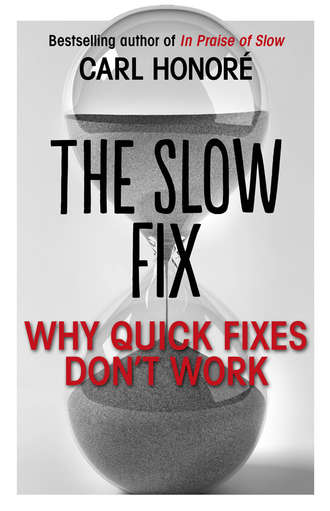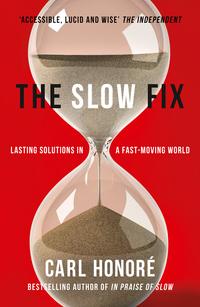
Полная версия
The Slow Fix: Why Quick Fixes Don’t Work (extract)

THE SLOW FIX: why quick fixes don't work (extract)
Extracted from
The Slow Fix: solve problems, work smarter and live better in a fast world
By
Carl Honoré

Contents
Cover
Title Page
EXTRACT: why quick fixes don't work
Copyright
About the Publisher
EXTRACT
why quick fixes don't work
How poor are they who have not patience!What wound did ever heal but by degrees?
William Shakespeare
In a small, windowless room, in a busy clinic in south London, a familiar ritual is about to begin. Let’s call it Man with Back Pain Visits Specialist.
You may recognise the scene: the white walls are bare apart from an anatomical poster and a few smudged fingerprints. Fluorescent light falls from a bulb overhead. A faint whiff of disinfectant hangs in the air. On a trolley beside the treatment table, acupuncture needles are spread out like the tools of a medieval torturer.
Today, I am the man seeking relief from back pain. Face down on the treatment table, peering through a foam ring wrapped in tissue paper, I can see the hem of a white lab coat swishing above the floor. It belongs to Dr Woo, the acupuncturist. Though nearing retirement, he still moves with the liquid grace of a gazelle. To the hobbled masses in his waiting room, he is a poster boy for the benefits of Traditional Chinese Medicine.
Dr Woo is planting a small forest of needles along my spine. Each time he punctures the skin, he lets out a muffled grunt of triumph. And each time the sensation is the same: a prickling heat followed by an oddly pleasant contraction of the muscle. I lie still, like a butterfly yielding to a Victorian collector.
After inserting the final needle, Dr Woo dims the lights and leaves me alone in the half-darkness. Through the thin walls I can hear him chatting with another patient, a young woman, about her back trouble. Later, he returns to pull out my needles. My spirits are already lifting as we walk back to Reception. The pain has eased and my body is moving more freely, but Dr Woo remains cautious.
‘Do not get carried away,’ he says. ‘Backs are complicated and they need time to heal properly, so you must be patient.’ I nod, looking away as I hand over my credit card, knowing what is coming next. ‘You should do at least five more sessions,’ he tells me.
My response is the same as last time, the same as always: make a follow-up appointment while secretly planning to dodge it.
Two days later and, true to form, my back has improved enough that I cancel my return visit, feeling slightly smug about the time, hassle and money this will save. Who needs multiple rounds of acupuncture, anyway? One hit and I’m back in the game.
Or am I? Three months later I’m back on Dr Woo’s treatment table and this time the pain is snaking down into my legs. Even lying in bed hurts.
Now it is Dr Woo’s turn to be smug. While laying out his needles, he tells me that impatience is the enemy of good medicine, and then he gets personal. ‘Someone like you will never get better,’ he says, more in sorrow than in anger. ‘Because you are a man who wants to fix his back quickly.’
Ouch.
Talk about a diagnosis that hits where it hurts. Not only am I guilty as charged – I have been in a hurry to fix my back for 20 years – but I really should know better. After all, I travel the world lecturing on how wonderful it is to slow down, take time, do things as well, rather than as fast, as possible. I have even sung the praises of slowness at medical conferences. But though my life has been transformed by deceleration, the virus of hurry still clearly lurks in my bloodstream. With surgical precision, Dr Woo has skewered an inconvenient truth that I have ducked for years: When it comes to healing my back, I remain addicted to the quick fix.
My medical history reads like a whistle-stop tour. Over the last two decades my back has been twisted, cracked and stretched by a procession of physiotherapists, masseurs, osteopaths and chiropractors. Aromatherapists have rubbed birch, blue chamomile and black pepper oils into my lower lumbar region. Reflexologists have worked the back-related pressure points on the soles of my feet. I have worn a brace, guzzled painkillers and muscle relaxants, and spent a small fortune on ergonomic chairs, orthotic insoles and orthopedic mattresses. Hot stones, hot cupping, electric currents, heat pads and ice packs, crystals, Reiki, ultrasound, yoga, Alexander Technique, Pilates – yup, been there, done all of that. I have even visited a Brazilian witch doctor.
Yet nothing has worked. Sure, there have been moments of relief along the way, but after two decades on the treatment treadmill my back still aches – and it’s getting worse.
Perhaps I just haven’t found the right cure for me. After all, others have conquered back pain using techniques from my treatment plan, and even that Brazilian witch doctor came with glowing references. Or maybe, and this seems far more likely, Dr Woo is right. In other words, I treat every single cure for back pain as a quick fix, targeting the symptoms without addressing the root cause, revelling in its temporary relief, chafing when progress slows or demands more effort before moving on to the next treatment at the drop of a hat, like a chronic weight-watcher flitting from one diet to the next. The other day I spotted a web link peddling ‘Magnet Therapy’ as a panacea for back pain. My first thought was not: ‘Snake oil, anyone?’ It was: ‘Can I get that in London?’
This book is not a back pain memoir. Nothing is more tedious than listening to other people drone on about their aches and ailments. What makes my losing battle with my lumbar region worth exploring is that it points up a much bigger problem affecting every one of us. Let’s be honest: when it comes to chasing instant results, I am not alone. In every walk of life, from medicine and relationships to business and politics, we are all hooked on the quick fix.
Looking for shortcuts is nothing new. Two thousand years ago Plutarch denounced the army of quacks hawking miracle cures to the gullible citizens of Ancient Rome. At the end of the eighteenth century infertile couples queued up in hope of conceiving in London’s legendary Celestial Bed. The amorous contraption promised soft music, a ceiling-mounted mirror and a mattress stuffed with ‘sweet new wheat or oat straw, mingled with balm, rose leaves, and lavender flowers’, as well as tail hairs from the finest English stallions. An electric current allegedly generated a magnetic field ‘calculated to give the necessary degree of strength and exertion to the nerves’. The promise: instant conception. The cost for one night of fertile fumbling: £3,000 in modern money.
Today, though, the quick fix has become the standard across the board in our fast-forward, on-demand, just-add-water culture. Who has the time or patience for Aristotelian deliberation and the long view any more? Politicians need results before the next election, or the next press conference. The markets panic if wobbly businesses or wavering governments fail to serve up an instant action plan. Websites are studded with ads promising fast solutions to every problem known to Google: a herbal remedy to reboot your sex life; a video to perfect your golf swing; an app to find Mr Right. In the old days, social protest entailed stuffing envelopes, going on marches or attending meetings in town halls. Now many of us just click ‘Like’ or fire off a sympathetic tweet. All over the world, doctors are under pressure to heal patients in a hurry, which often means reaching for a pill, the quick fix par excellence
Конец ознакомительного фрагмента.
Текст предоставлен ООО «ЛитРес».
Прочитайте эту книгу целиком, купив полную легальную версию на ЛитРес.
Безопасно оплатить книгу можно банковской картой Visa, MasterCard, Maestro, со счета мобильного телефона, с платежного терминала, в салоне МТС или Связной, через PayPal, WebMoney, Яндекс.Деньги, QIWI Кошелек, бонусными картами или другим удобным Вам способом.





